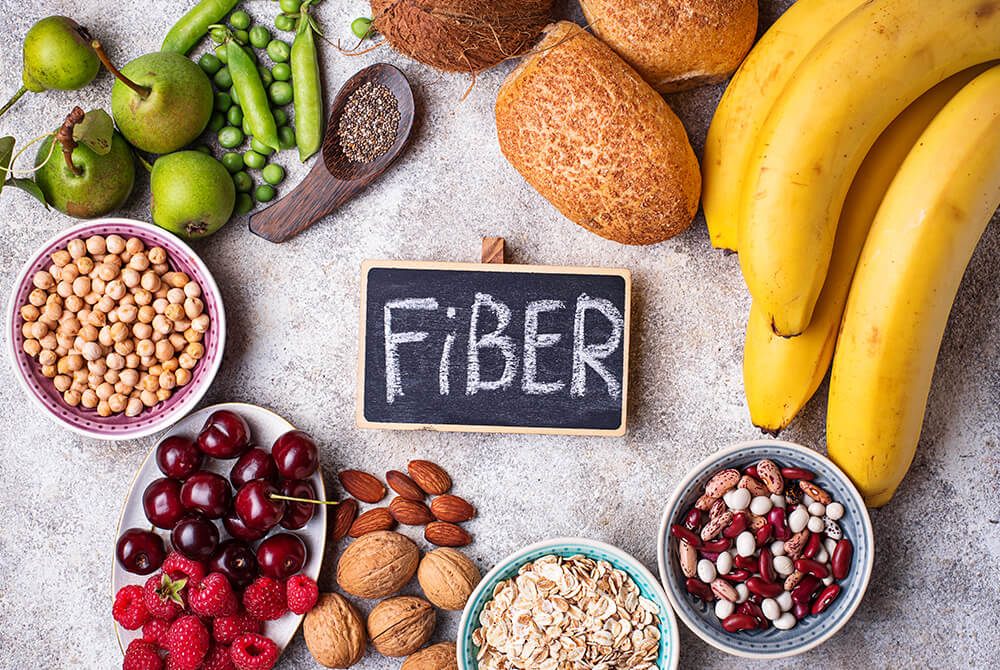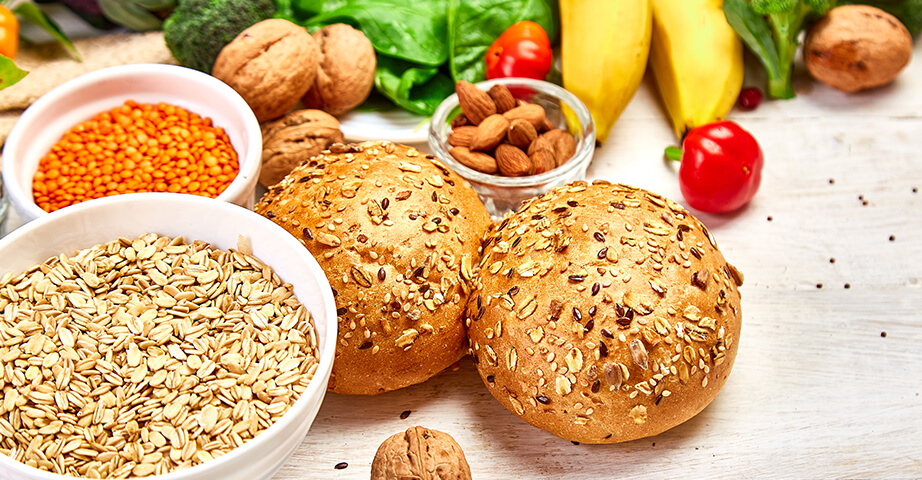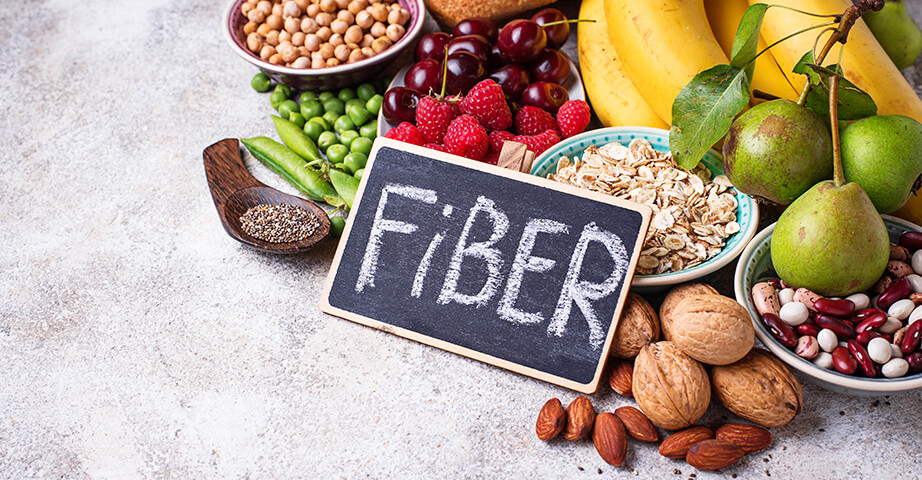Dietary fibre – properties, sources and effects on the body

Fibre is a group of various compounds of plant origin that are not digested in the human gastrointestinal tract. For a long time, it was considered an ingredient completely unnecessary in our diet. Currently, it is known that this dietary fibre has numerous health-promoting properties, and its consumption in optimal amounts supports the proper functioning of the body. What is fibre and in which products is it the most? How to increase the consumption of this important substance?
Summary
What is fibre?
The first person who used the term „dietary fibre” is recognized British doctor Eban Hipsley. In the fifties of the XX century, this name was defined by compounds undigested by the human digestive system, which are part of the cell walls of plants.
The definition of dietary fibre has been modified for many years. It is now known that dietary fibre consists of many substances such as complex carbohydrates (polysaccharides) and lignin, which are resistant to digestive enzymes. It also includes mucilages, gums, waxes and beta-glucans.
For a long time, it was thought that fibre in the human diet is unnecessary, because it does not perform any functions. The truth is completely different. Numerous studies show that people who follow a diet containing the optimal amount of this ingredient are less likely to develop diabetes, stroke, cardiovascular disease. In order for fibre to have a positive effect on the body, it must be supplied to the body in the presence of water.
From the point of view of human physiology, there are two basic fractions of dietary fibre:
- soluble,
- insoluble.
Soluble fibre has the ability to dissolve in water and is fermented in the intestines by bacteria of the intestinal microbiota. These include substances such as pectins, mucilages, gums, beta-glucans, resistant starch and some hemicelluloses. A good source of soluble fraction is, among others, psyllium husk, oat bran, apples, gooseberries, currants.
Insoluble fibre undergoes only minor changes in the human gastrointestinal tract. It includes such compounds as cellulose and lignin. Insoluble dietary fibre supports the functioning of the digestive system, supports intestinal peristalsis, and also facilitates defecation. Thanks to this fraction, there is an increase in stool volume and efficient removal of toxins from the digestive system. Insoluble fibre can be found in nuts, seeds, whole grains, and in the peels of fruits and vegetables.
How does fibre work on the body?
Although soluble and insoluble fibre fractions perform other functions in the body, they are usually both found in food and are delivered to the body along with the daily diet. Each of them is important for the health and proper functioning of the body. However, it is worth knowing how individual types of this dietary fibre can affect the body.
Soluble fibre can improve satiety, slow down the passage of food content, as well as bind toxic compounds and accelerate their removal from the gastrointestinal tract. In addition, it may delay the absorption of glucose from the digestive system into the blood, support the regulation of lipid metabolism (by reducing cholesterol and binding excess bile acids) and support the formation of short-chain fatty acids, such as butyric acid, which is a source of energy for intestinal epithelial cells.
Many sources suggest that soluble dietary fibre may also be an important factor reducing the risk of developing cardiovascular diseases, including ischaemic heart disease.
What are the functions of insoluble fibre? This fraction may be responsible for stimulating chewing and salivation, increasing the volume of food content in the small intestine and easier defecation. In addition, this fraction of dietary fibre can support the secretion of gastrointestinal hormones and digestive juices, stimulate intestinal blood supply and colon peristalsis, as well as prevent constipation and the development of diseases associated with rectal varicose veins, polyps or diverticulosis.
Recommended fibre products
Fibre and weight loss
Many scientific studies show that the properties of dietary fibre can positively affect weight reduction in case of overweight or obesity and contribute to lowering the value of the BMI index.
In the context of weight loss, the presence of dietary fibre:
- it provides a long-lasting feeling of satiety, which affects the inhibition of the desire to snack and reduce the amount of calories consumed,
- it slows down the absorption of sugars from the digestive system, which prevents rapid jumps in blood glucose,
- it improves the process of removing toxins and heavy metals from the body by cleansing the digestive tract.
The most effective effect of fibre on weight loss can be obtained by providing the body with both fractions of dietary fibre in physiological proportions. Soluble fibre absorbs water and thus increases its volume in the stomach. In turn, insoluble fibre affects the stimulation of intestinal function, contributing to the reduction of absorption of nutrients in the body, which affects the delivery of smaller amounts of food and energy.
To speed up the process of weight reduction, can also include preparations with fibre in the diet. On the market, there are supplements available in the form of tablets, capsules, as well as powder for dissolving in water. They can be helpful for people who have problems with including the right amount of products rich in this compound in the menu.
Daily requirement for dietary fibre
Excessive consumption of highly processed foods and the renoucement of whole grain cereal products have caused that the diet of many people is poor in dietary fibre. Deficiency of this component in the menu can cause disorders of homeostasis of the body, problems with defecation, and also increase the risk of developing diseases such as hemorrhoids, cholelithiasis or type II diabetes.
According to the recommendations of the World Health Organization (WHO), adults should consume 25 g of dietary fibre per day. This amount of dietary fibre allows the body to function properly. The consumption of this ingredient may be lower in special cases, for example in seniors during convalescence after a disease.
It is very important that, at the same time as the appropriate supply of dietary fibre, take care of the right amount of water in the diet. It is necessary because fibre swells in the gastrointestinal tract and in its absence can turn into a compact structure, which can exacerbate constipation and abdominal pain. Therefore, with a diet rich in fibre, you should drink at least 2 litres of water per day.

Where is the most fibre?
The main source of dietary fibre in the diet is food of plant origin: cereal products, nuts, seeds, as well as vegetables and fruits.
Food products rich in fibre include primarily:
- oat flakes,
- oat bran,
- vegetables (carrots, parsley, Brussels sprouts, aubergine, broccoli, spinach, tomatoes),
- fruits (raspberries, apples, strawberries, oranges, pears, blueberries, bananas),
- whole grain cereal products (e.g. wholemeal bread),
- nuts,
- dried fruits (plums, apricots, dates, figs),
- legumes (peas, chickpeas, lentils),
- flaxseed.
When considering where fibre is, it is worth knowing that vegetables provide this ingredient in an average amount of 0.5-5.8 g/100 g of the product, while fruits about 2.0 g/100 g of the product. The fibre content of many foods is not too high, so the variety of food consumed is extremely important. Using a healthy and properly balanced menu based on vegetables, fruits and whole grains, meeting the need for dietary fibrer becomes a much easier task.
Although dietary fibre is a healthy ingredient, you should not overdo it with its consumption. Excess fibre can cause diarrhea, bloating, abdominal pain, and also interfere with the absorption of certain minerals in the small intestine. Therefore, the content of this dietary fibre should be increased gradually.
Fibre supplementation
In a situation where it is impossible to meet the needs of the body for dietary fibre with the help of a daily menu, then can be considered the use of dietary supplements. However, it should be remembered that they should not replace healthy and balanced nutrition, and taking them is always worth consulting a doctor or dietitian in advance. Properly selected preparation can be a support in the process of losing weight and maintaining a healthy body weight, as well as in improving the work of the intestines.
Fibre in tablets, powder - which one to choose?
The best fibre for the intestines is one that is supplied to the body with daily food. In the case of increased demand for this ingredient, you can reach for a fibre supplement in the form of easy-to-swallow tablets or powder for dissolving in water.
The capsules contain a precisely measured portion of dietary fibre and can be taken without mixing with liquids. For this reason, fibre in tablets can be a great solution for people who are busy and lead an intense lifestyle. Capsules are a quick and convenient option, because you just need to drink them with the right amount of water.
People who have difficulty swallowing tablets can reach for fibre powder. Supplements in this form can be used as an addition to oatmeal, yogurt, cocktail, etc. Powdered dietary fibre can also be added to various dishes: vegetables, salads, desserts. It should only be remembered that preparations containing fibre powder are more susceptible to moisture, so you need to store them in a dry place at room temperature.

Vital fibre
In the context of fibre supplementation playing an important role in the functioning of the human digestive system, you can often come across the concept of vital fibre. Many people do not know exactly what this compound is and what properties it has.
What is it and what gives vital fibre? This type of ingredient is called insoluble fibre of natural origin, which occurs only in two plants, such as psyllium husk and ispaghula. It is obtained by grinding their seeds, and its most important components include cellulose and lignin.
Vital fibre can be purchased in the form of dietary supplements in the shape of tablets or ground powder.
Dietary fibre - summary
Dietary fibre, which is an important element of a healthy and balanced diet, affects not only the maintenance of normal body weight. As research suggests, consuming this ingredient in the right amount has a positive effect on the intestinal bacterial flora, lowers cholesterol, slows down the absorption of fats and reduces the risk of diabetes.
Despite the positive effect on the body, you should not consume foods rich in dietary fibre in huge quantities. Contraindications to the use of a diet rich in fibre are, among others, catarrhal gastrointestinal tract, damage to the gastric and pancreatic mucosa, postoperative conditions and mineral deficiencies.

